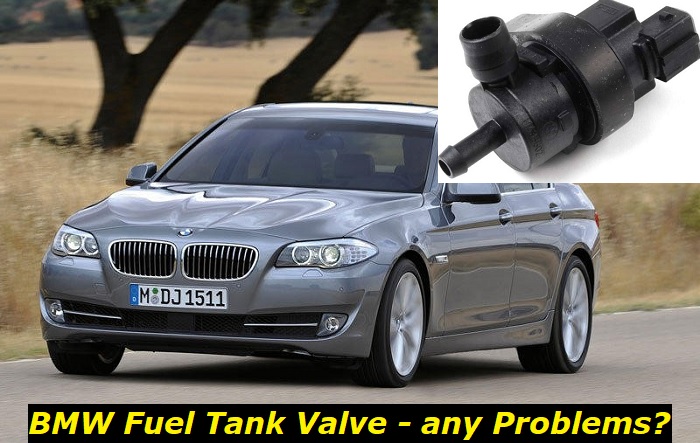BMW is known for its high level of quality control, that's why it has consistently ranked on top in terms of luxury vehicle sales in the U.S. However, there are problems commonly found in its fuel tank vent that you should definitely keep a lookout for.
Engine electrical problems highlights
- Level of urgency:high
- DIY inspection:possible but complicated
- DIY repairs:impossible
- Can you drive?yes, if it starts
- Price of repairs:$150 - $650
- If ignored:no-start, harsh work, warning lights
- Ways to fix:good scanning for codes, professional repairs

How the Fuel Tank Vent Valve Works
The fuel tank vent valve is a one-way valve that allows air to enter the fuel tank as the fuel is consumed. It is usually located on the top of the fuel tank, near the filler neck.
This part prevents the formation of a vacuum in the tank, which could impede fuel flow. The valve also allows any vapors that may have accumulated in the tank to be released, preventing pressure build-up.
Fuel tank vent valves are an important safety feature in vehicles, and can help prevent major problems such as stalling or engine failure.
Common Problems Related to the Fuel Tank Vent Valves of BMW Cars
Here are the symptoms of fuel tank vent valve problems in BMW cars as well as ways for you to easily diagnose the primary cause of the issues for their quick resolution:
1. Fuel Tank Vent Valve Clogging
Clogging is the most common problem found in the fuel tank vent valves of BMW cars. However, it is important to keep the problem from becoming severe by having the valve cleaned and inspected regularly.
This problem can cause a variety of symptoms, including engine stalling, poor fuel economy, and difficulty starting the car. If left unchecked, fuel tank vent valve clogging can lead to more serious problems, such as engine damage that will require your power unit to be rebuilt or replaced in the long run.
There are several possible causes of fuel tank vent valve clogging. One is a build-up of dirt and debris in the valve itself. This can happen if the car is driven in dusty or dirty conditions. Another possible reason is a blockage in the hose that leads from the valve to the atmosphere. This blockage can be caused by a variety of things, including small leaves, tiny insects, or snow build-up.
If a blockage does occur, it is important to have it removed as soon as possible to prevent damage to the engine. There are several methods of clearing the fuel tank vent valve from clogs that you can do yourself.
One is to use a small piece of wire to gently remove any dirt or debris that may be blocking the valve. Another is to use a vacuum cleaner to suck out any blockages in the hose. If these methods don't work, the valve can be cleared by using a solvent such as carburetor cleaner.
If the fuel tank vent valve is severely clogged and can no longer be cleaned, it may need to be replaced. This is can be easily done by a qualified mechanic. Likewise, if the valve is damaged beyond repair, it will have to be replaced with a new one.
2. Corrosion in Fuel Tank Vent Valve
Fuel tank vent valve corrosion is a serious problem that can occur in BMW cars. The symptoms of this problem include a loss of power, stalling, and engine misfires. If the problem is not addressed immediately, it can lead to engine damage or even complete engine failure.
The factors that are possibly causing this problem include poor quality gasoline, water contamination, and extended periods of idling. The possible solutions to this problem include replacing the fuel filter, adding a fuel additive to the gasoline, and replacing the fuel tank vent valve. Parts replacement is a must if the corrosion is too severe.
It is important to address corrosion problems in the fuel tank vent valve as soon as the symptoms appear. The kinds of major damage that can result from fuel tank vent valve corrosion are extensive but these can perfectly ruin a good engine if left unchecked.
Taking preventative measures, such as using high-quality gasoline and adding a fuel additive to the gasoline, can help to avoid this problem.
3. Worn Fuel Tank Vent Valve Seals
Leaks in the fuel tank vent valve of BMW cars can cause a multitude of problems. The most common symptom is a pungent fuel smell coming from the car, which can be detected both inside and outside the vehicle. Other symptoms include a decrease in fuel economy and an increase in engine noise. If the problem is not addressed immediately, it can lead to fuel system damage, engine failure, and even fire.
The most common cause of leaks in the fuel tank vent valve is a failed gasket or seal. This can be caused by age, heat, or exposure to chemicals. Another possible cause is damage to the valve itself, which can happen if the car is involved in an accident or if the valve is not installed correctly.
The best way to prevent leaks in the fuel tank vent valve is to have the car regularly serviced by a qualified mechanic. This will ensure that the valve is in good condition and that any potential problems are detected early. If a leak does occur, it is important to have the car repaired as soon as possible to avoid further damage.
There are a few ways to repair a fuel tank vent valve leak. The most common is to replace the gasket or seal. If the valve itself is damaged, it may need to be replaced as well. In some cases, parts such as the fuel pump or fuel injectors may need to be replaced as a result of a chain of events originating from this component.
If you are experiencing any of the symptoms of a fuel tank vent valve leak, it is important to have the car serviced by a qualified mechanic as soon as possible. This will help prevent further damage and ensure that the problem is fixed correctly.
4. Gasoline or Diesel Climbing Up the Fuel Tank Vent Valve
If you notice that fuel is climbing up the fuel tank vent valve in your BMW car, it is a problem that necessitates an immediate resolution. The failure to do so can trigger plenty of other problems in the other parts of your vehicle that can be more expensive and more complex to fix.
To diagnose the problem, you can first inspect the fuel tank vent valve for any damage or debris. If there is debris blocking the valve, you can clean it out using the solution discussed in the first item of this list. If the valve is damaged, you will need to replace it.
There are several factors that could be causing the problem with the fuel tank vent valve. One possibility is that the gas cap is not tight enough, which you can easily remedy by making sure that it screws well. If it no longer seals properly, then it's time for you to change it.
Another possibility is that there is a problem with the fuel line. If the fuel line is leaking, it will need to be replaced.
One more factor to consider is problems in the pressure regulator. If the pressure regulator is not working as it should, it can force the fuel tank to overpressurize and rupture.
If the problem with the fuel tank vent valve is not addressed immediately, it can result in serious damage to your car. The fuel tank could rupture and cause a fire. Additionally, the pressure in the fuel tank can build up and cause the tank to explode. Likewise, too much vacuum in the system can lead to the implosion of the tank.
If you notice any of these problems with your fuel tank vent valve, it is important to take your car to a mechanic as soon as possible. They will be able to diagnose the problem and make the necessary repairs. In some cases, parts may need to be replaced or simply cleaned depending on the nature of the issue.
Conclusion
Detecting fuel tank vent valve problems in your BMW car early on by paying close attention to their symptoms can save you a lot of trouble in the long run. This will allow you to tackle them early on before they get any worse.
It is important to have a certified BMW mechanic inspect your car if you notice any of these problems. They will most likely be able to diagnose the problem and recommend the best course of action.
In most cases, parts will need to be replaced. However, if the damage is severe enough, it may negatively affect the durability and proper operation of your car's mechanical parts, including the engine. But then again, if the problem is caught early enough, it can often be fixed with simple cleaning or seal repairs. Lastly, you can easily dodge such issues through regular maintenance and appropriate care for your auto.
About the authors
The CarAraC research team is composed of seasoned auto mechanics and automotive industry professionals, including individuals with advanced degrees and certifications in their field. Our team members boast prestigious credentials, reflecting their extensive knowledge and skills. These qualifications include: IMI: Institute of the Motor Industry, ASE-Certified Master Automobile Technicians; Coventry University, Graduate of MA in Automotive Journalism; Politecnico di Torino, Italy, MS Automotive Engineering; Ss. Cyril and Methodius University in Skopje, Mechanical University in Skopje; TOC Automotive College; DHA Suffa University, Department of Mechanical Engineering






Add comment